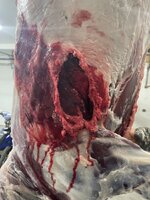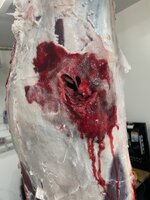From a scholarly review of wound trauma:
In the most general terms, wounding will likely be limited to a short distance beyond the permanent cavity if the projectile lost a relatively small amount of energy as it penetrated. This may be because the projectile had relatively low impact energy, because it did not expand quickly to sharply increase local forces, and/or because it penetrated through-and-through without losing a lot of energy. In contrast, high impact energy, an expanded projectile, or a projectile stopped in tissue suggest the possibility of more extensive wounding.
There, the article is considering nerve damage, blood vessel damage, and other injuries that will not directly cause death in humans or animals.
——————
The potential for temporary cavitation to cause wound trauma is related to the anatomical location of the bullet path, the degree of bullet fragmentation (if any) and the size of the temporary cavity, usually expressed in a maximum diameter or volume.
There, the article says that the temporary cavitation grows with more fragmentation as the “energy dumped” into the soft tissue causes a greater pressure wave.
It also notes that fragmentation of the bullet can cause more trauma when it passes through the soft tissue that is compressed at the edge of the cavity, so the small fragments are cutting more tissue.
It’s the difference between stabbing a piece of foam while it is expanded, the hole is the size of the knife. But, when the foam is compressed the knife cuts much more, so that when it expands the hole is much larger than the blade.
Additionally, when the energy is dumped into soft tissue that is filled with liquid, the liquid doesn’t compress and so it creates an even greater wave and cavitation.
Physics says that “dumping the energy” in an inelastic fluid dense tissue will create an “explosive” action rupturing the tissue holding the fluids.
That is why hunters regularly say “the lungs were jellied” by a match bullet.
Jelly the lungs with a shot behind the shoulder, and you don’t need to do tracking. I never have.
You want a pass through, fine. You can have it. But, you can’t have jellied lungs unless it is a big fragmenting bullet that passes through. Or, velocity is high, meaning, you are close.
This is just one article. I will dig up more.
In the most general terms, wounding will likely be limited to a short distance beyond the permanent cavity if the projectile lost a relatively small amount of energy as it penetrated. This may be because the projectile had relatively low impact energy, because it did not expand quickly to sharply increase local forces, and/or because it penetrated through-and-through without losing a lot of energy. In contrast, high impact energy, an expanded projectile, or a projectile stopped in tissue suggest the possibility of more extensive wounding.
There, the article is considering nerve damage, blood vessel damage, and other injuries that will not directly cause death in humans or animals.
——————
The potential for temporary cavitation to cause wound trauma is related to the anatomical location of the bullet path, the degree of bullet fragmentation (if any) and the size of the temporary cavity, usually expressed in a maximum diameter or volume.
There, the article says that the temporary cavitation grows with more fragmentation as the “energy dumped” into the soft tissue causes a greater pressure wave.
It also notes that fragmentation of the bullet can cause more trauma when it passes through the soft tissue that is compressed at the edge of the cavity, so the small fragments are cutting more tissue.
It’s the difference between stabbing a piece of foam while it is expanded, the hole is the size of the knife. But, when the foam is compressed the knife cuts much more, so that when it expands the hole is much larger than the blade.
Additionally, when the energy is dumped into soft tissue that is filled with liquid, the liquid doesn’t compress and so it creates an even greater wave and cavitation.
Physics says that “dumping the energy” in an inelastic fluid dense tissue will create an “explosive” action rupturing the tissue holding the fluids.
That is why hunters regularly say “the lungs were jellied” by a match bullet.
Jelly the lungs with a shot behind the shoulder, and you don’t need to do tracking. I never have.
You want a pass through, fine. You can have it. But, you can’t have jellied lungs unless it is a big fragmenting bullet that passes through. Or, velocity is high, meaning, you are close.
This is just one article. I will dig up more.


